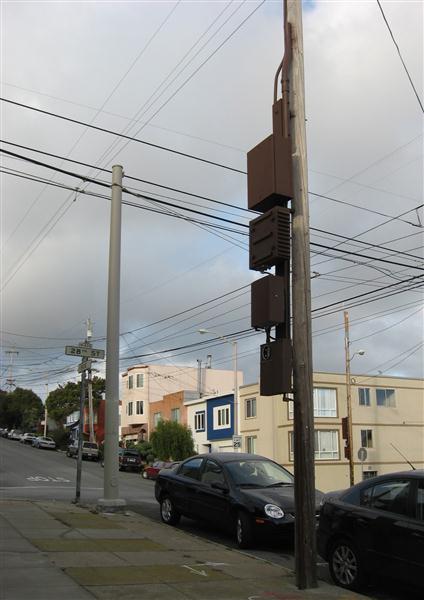
RETURN TO HOME PAGE
FEEDBACK

|
December-January
2009
RETURN TO HOME PAGE FEEDBACK |
By Corrie M. Anders

Neighbors were surprised by the sudden appearance last month of
T-Mobile antennas and equipment boxes on two poles at 28th and Noe
streets.
Photo by Sally Smith
Without any notice to residents, a national cell phone company has begun installing a web of wireless antennas on public utility poles in Noe Valley.The work began in November as part of T-Mobile's plan to increase cell phone coverage in San Francisco. The effort will continue until the end of the year at four locations in Noe Valley and 34 other sites in the city.
The work has vexed a number of local residents, who complain that the antennas and their unsightly equipment boxes came out of the blue.
Vicki Rosen says she chanced upon the work in progress at Valley and Church streets during a morning walk near her home.
"They're just hideous," said Rosen, president of Upper Noe Neighbors, a civic watchdog organization. "They are the most visually appalling boxes."
Luke Tran also was troubled last month to find work crews putting up sets of antennas and boxes on two poles near the intersection of Noe and 28th streets.
Tran said he was worried about the potential health effects of radio-frequency radiation exposure and that the antennas might decrease the value of the Noe Street home he purchased two years ago.
"No one notified me. I think that's unfair," said Tran, an accountant.
Unfair or not, San Francisco lacks authority to require hearings for cell phone equipment installed on public rights of way, such as streets and sidewalks. That's because regulation of wireless communication companies falls under federal and state jurisdiction.
Frustrated, Tran founded the Noe Valley Group to raise awareness in the neighborhood, although his battle to block the current crop of T-Mobile antennas may be lost.
"It's kind of too late to stop them because they're half built," he said. "But you can at least get the message out. Who's to say that Horizon or some other company wouldn't start building them and...it just snowballs into quite a bit more."
In addition to the public sites near the homes of Tran and Rosen, T-Mobile antennas are being installed at the corner of Fair Oaks and 23rd Street and on Sanchez Street near Alvarado Street.
The antenna equipment is contained within a stack of four brown boxes--two the size of suitcases--strapped onto utility poles about two stories high. In addition, the poles have a 10-foot extension at the top to hold a "radome,'' which is a weatherproof cylinder that houses three antennas.
Rod De La Rosa, a T-Mobile senior manager, said the company met "all relevant and appropriate siting guidelines and regulations" before the work began. That included getting the requisite environmental exemptions, which the city's Planning Department granted Sept. 16.
He disagreed that the antennas hurt property values. "While there has been public concern about the impact these sites may have on property values..., to date there is no factual evidence that shows that there is an adverse effect."
The city's Department of Public Health addressed the radiation issue as part of T-Mobile's exemption request. The department said the maximum emissions the antennas would produce would be 19 percent of "applicable public exposure limits."
The city does have authority to regulate and hold public hearings for antennas on private property.
But a representative for Mayor Gavin Newsom could offer Tran little more than sympathy.
"I agree with you that the process is unfair and unbalanced," Alex Randolph, the mayor's liaison to District 8, wrote Tran and his wife, Eva Yuen, in an email:
"The City has unfortunately not a lot to regulate when a utility company like T-Mobile wants to install cell towers on public property. No hearings or notice is required for that to take place," he noted.
Randolph said that the mayor's office "has dealt with similar issues with AT&T and other wireless companies and we lost in court every single time, since the state government is the entity that has jurisdiction in this area."
However, a Ninth Circuit federal appeals court recently issued a ruling that would allow San Francisco more oversight in the future, according to San Francisco activist Doug Loranger.
The Oct. 14 decision, in a case involving Sprint and the city of Palos Verdes Estates in Southern California, gives "local governments the right to regulate on aesthetic grounds," said Loranger, a co-founder of the San Francisco Neighborhood Antenna-Free Union (SNAFU).
The San Francisco Board of Supervisors would have to enact the necessary legislation.
"Residents should be frustrated and angry they are not getting notices...in light of these recent court cases giving local governments authority to regulate more stringently," Loranger said.
That captures Tran's sentiments, though he's no Luddite. Like most people, his cell phone is an integral part of his life.
"My point is there are already enough of them up and running," he said. "There's not a single place in Noe Valley where I can't get coverage."
To contact the Noe Valley Group, email Tran at luketran@rocketmail.com.